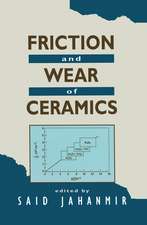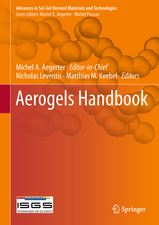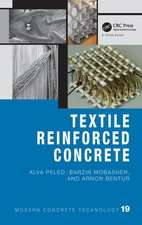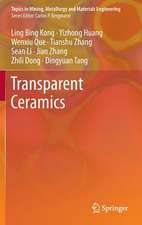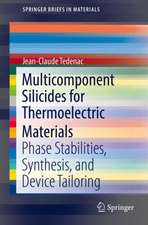Predictive Process Control of Crowded Particulate Suspensions: Applied to Ceramic Manufacturing
Autor James E. Funk, Dennis R. Dingeren Limba Engleză Paperback – 25 feb 2014
| Toate formatele și edițiile | Preț | Express |
|---|---|---|
| Paperback (1) | 3583.49 lei 6-8 săpt. | |
| Springer Us – 25 feb 2014 | 3583.49 lei 6-8 săpt. | |
| Hardback (1) | 3583.46 lei 6-8 săpt. | |
| Springer Us – 29 noi 1993 | 3583.46 lei 6-8 săpt. |
Preț: 3583.49 lei
Preț vechi: 4370.11 lei
-18% Nou
Puncte Express: 5375
Preț estimativ în valută:
685.68€ • 715.92$ • 567.50£
685.68€ • 715.92$ • 567.50£
Carte tipărită la comandă
Livrare economică 04-18 aprilie
Preluare comenzi: 021 569.72.76
Specificații
ISBN-13: 9781461363644
ISBN-10: 1461363640
Pagini: 828
Ilustrații: XXXVII, 786 p. 32 illus.
Dimensiuni: 155 x 235 x 43 mm
Greutate: 1.14 kg
Ediția:1994
Editura: Springer Us
Colecția Springer
Locul publicării:New York, NY, United States
ISBN-10: 1461363640
Pagini: 828
Ilustrații: XXXVII, 786 p. 32 illus.
Dimensiuni: 155 x 235 x 43 mm
Greutate: 1.14 kg
Ediția:1994
Editura: Springer Us
Colecția Springer
Locul publicării:New York, NY, United States
Public țintă
ResearchDescriere
Wisdom is the principal thing; therefore get wisdom; and with all thy getting, get understanding. Proverbs 4:7 In the early chapters of the book of Proverbs there is a strong emphasis on three words: knowledge, understanding, and wisdom. Perhaps we can apply these words to our philosophy behind the technology of Predictive Process Control. Knowledge is the accumulation of information provided by education as we begin to store the data in our brains that should prepare us for the challenges of the manufacturing environment. It applies to every level and every opportunity of education, formal and informal. This is simply to Know, without any requirement except a good memory, and is the basis for the following two thoughts. Understanding is the assimilation of knowledge, or the thinking process, as we begin to arrange and rearrange the data we Know for quick recall as it may be needed. This also applies to every level and opportunity of education. It is Know-Why based upon what we Know, and it requires some scepticism of oversimplified answers and a hunger for mental consistency. Wisdom is the application of both knowledge and understanding in real life enterprises. As we apply both our knowledge and understanding in those situations, all three are further enhanced by each progressive experience. This is that wonderful Know-How - to apply our education based upon Know-why, which was based upon Knowledge - which provides the confidence we need to advance in all phases of performance.
Cuprins
List of Figures. List of Tables. Principal Symbols. Foreword. Preface. 1. Introduction to Predictive Process Control. I: The Fundamental Principles of Particle Physics. 2. Introduction to Particle Physics. 3. Introduction to Particle Size. 4. Review of Packing in Polydisperse Particle Systems. 5. Fundamentals of Particle Packing, Monodisperse Spheres. 6. Derivation of the Dinger-Funk Particle Size Distribution Equation. 7. Packing of Discrete versus Continuous Particle Size Distributions. 8. Computer Modelling of Particle Packing Phenomena. 9. Computational Methods applied to Experimental Distributions. 10. The Particle Crowding Index (PCI) and the InterParticle Separation Distance (IPS). 11. Surface Area. 12. Porosity and Pore Size Distribution. 13. Reaction Paths during Firing. II: The Fundamental Principles of Interparticle Chemistry. 14. Introduction to Interparticle Chemistry. 15. Van der Waals Energy of Attraction. 16. The Electrical Double Layer. 17. The Role of the Liquid Medium. 18. Chemical Additives for Forming Processes. III: The Fundamental Principles of Rheology. 19. Introduction to the Rheology of Crowded Suspensions. 20. Viscosity and Rheology. 21. Shear-Thinning and Dilatant Rheologies. 22. A Computer Model for Rheology: Proving the Existence and Cause of Dilatancy. IV: Applications to Ceramic Forming Processes. 23. Introduction to Ceramic Forming Processes. 24. Practical Rheology. 25. Milling or Comminution. 26. High Intensity Mechanical Disperson (HID). 27. Slip Preparation and Data Interpretation. 28. Stability of Suspensions. 29. A Model for Controlled Drying and Firing Shrinkage. 30. Slip Casting at Atmospheric Pressure. 31. Filter Pressing Effects due to HID. 32. Spray Drying and Dry Pressing. 33. Extrusion and Extruders. 34. Plastic Forming. 35. Very High Solids Castable Refractories. V: Laboratory Methods, Measurements, and Interpretation of Data. 36. PPC Computer Programs. 37. Test Specifications for PPC Measurements. 38. Sampling and Test Frequency. 39. True Particle Density and Suspension Specific Gravity. 40. Specific Surface ARea. 41. Particle Size Distribution. 42. Particle Crowding Index. 43. Methylene Blue Index. 44. Mineral Analysis of Clays. 45. Rheological Properties. 46. Filter Press. VI: Applications to Drying Phenomena. 47. Drying and Dryer Design. Index.









